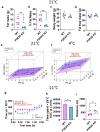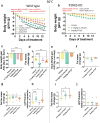A key role for P2RX5 in brown adipocyte differentiation and energy homeostasis
- PMID: 39484996
- PMCID: PMC11540092
- DOI: 10.1080/21623945.2024.2421745
A key role for P2RX5 in brown adipocyte differentiation and energy homeostasis
Abstract
Brown adipocytes are defined based on a distinct morphology and genetic signature that includes, amongst others, the expression of the Purinergic 2 Receptor X5 (P2RX5). However, the role of P2RX5 in brown adipocyte and brown adipose tissue function is poorly characterized. In the present study, we conducted a metabolic characterization of P2RX5 knockout male mice; next, we characterized this purinergic pathway in a cell-autonomous context in brown adipocytes. We then tested the role of the P2RX5 receptor agonism in metabolic responses in vivo in conditions of minimal adaptive thermogenesis requirements. Our data show that loss of P2RX5 causes reduced brown adipocyte differentiation in vitro, and browning in vivo. Lastly, we unravel a previously unappreciated role for P2RX5 agonism to exert an anti-obesity effect in the presence of enhanced brown adipose tissue recruitment in male mice housed at thermoneutrality. Altogether, our data support a role for P2RX5 in mediating brown adipocyte differentiation and function that could be further targeted for benefits in the context of adipose tissue pathology and metabolic diseases.
Keywords: ATP; Purinergic receptors; adipogenesis; browning; sympathetic nerves.
Conflict of interest statement
No potential conflict of interest was reported by the author(s).
Figures




Similar articles
-
The Purinergic Receptor P2X5 Modulates Glucose Metabolism and Expression of Thermogenic Genes in Brown Adipose Tissue.Int J Mol Sci. 2025 Jul 4;26(13):6474. doi: 10.3390/ijms26136474. Int J Mol Sci. 2025. PMID: 40650249 Free PMC article.
-
ASC-1, PAT2, and P2RX5 are cell surface markers for white, beige, and brown adipocytes.Sci Transl Med. 2014 Jul 30;6(247):247ra103. doi: 10.1126/scitranslmed.3008490. Sci Transl Med. 2014. PMID: 25080478 Free PMC article.
-
Berardinelli-Seip congenital lipodystrophy 2/SEIPIN determines brown adipose tissue maintenance and thermogenic programing.Mol Metab. 2020 Jun;36:100971. doi: 10.1016/j.molmet.2020.02.014. Epub 2020 Mar 4. Mol Metab. 2020. PMID: 32246911 Free PMC article.
-
Revisiting the adipocyte: a model for integration of cytokine signaling in the regulation of energy metabolism.Am J Physiol Endocrinol Metab. 2015 Oct 15;309(8):E691-714. doi: 10.1152/ajpendo.00297.2015. Epub 2015 Sep 1. Am J Physiol Endocrinol Metab. 2015. PMID: 26330344 Review.
-
The adipose organ: white-brown adipocyte plasticity and metabolic inflammation.Obes Rev. 2012 Dec;13 Suppl 2:83-96. doi: 10.1111/j.1467-789X.2012.01039.x. Obes Rev. 2012. PMID: 23107262 Review.
Cited by
-
Indigenous broilers in crossbreeding: impacts on meat quality and candidate gene screening.Poult Sci. 2025 Jul;104(7):105245. doi: 10.1016/j.psj.2025.105245. Epub 2025 May 1. Poult Sci. 2025. PMID: 40344706 Free PMC article.
-
The Purinergic Receptor P2X5 Modulates Glucose Metabolism and Expression of Thermogenic Genes in Brown Adipose Tissue.Int J Mol Sci. 2025 Jul 4;26(13):6474. doi: 10.3390/ijms26136474. Int J Mol Sci. 2025. PMID: 40650249 Free PMC article.
-
Modulation of liver lipid metabolic pathways by central nervous system ER stress.Am J Physiol Endocrinol Metab. 2025 Jun 1;328(6):E833-E844. doi: 10.1152/ajpendo.00392.2024. Epub 2025 Apr 22. Am J Physiol Endocrinol Metab. 2025. PMID: 40261717 Free PMC article.
References
MeSH terms
Substances
Grants and funding
LinkOut - more resources
Full Text Sources
Other Literature Sources
